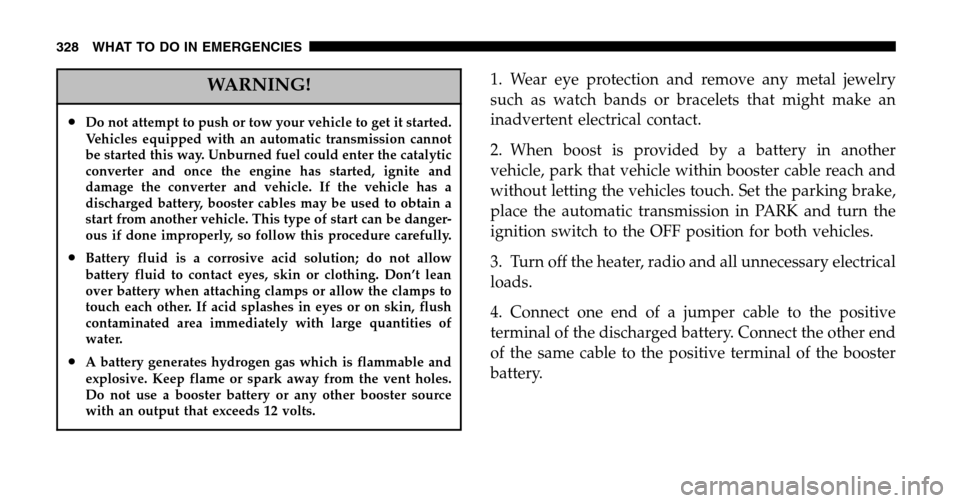Page 314 of 440
Towing Tips
Before setting out on a trip, practice turning, stopping
and backing the trailer in an area away from heavy
traffic.
Towing Tips — Automatic Transmission
The “D” range can be selected when towing. However, if
frequent shifting occurs while in this range, the “3” range
should be selected.
NOTE: Using the “3” range while operating the vehicle
under heavy operating conditions will improve perfor-
mance and extend transmission life by reducing exces-
sive shifting and heat build up. This action will also
provide better engine braking.
The automatic transmission fluid and filter should be
changed if you REGULARLY tow a trailer for more than
45 minutes of continuous operation. See Schedule “B” in
section 8 of this manual for transmission fluid change
intervals.
NOTE: Check the automatic transmission fluid level
before towing.
7- Pin Connector
314 STARTING AND OPERATING
Page 328 of 440

WARNING!
•Do not attempt to push or tow your vehicle to get it started.
Vehicles equipped with an automatic transmission cannot
be started this way. Unburned fuel could enter the catalytic
converter and once the engine has started, ignite and
damage the converter and vehicle. If the vehicle has a
discharged battery, booster cables may be used to obtain a
start from another vehicle. This type of start can be danger-
ous if done improperly, so follow this procedure carefully.
•Battery fluid is a corrosive acid solution; do not allow
battery fluid to contact eyes, skin or clothing. Don’t lean
over battery when attaching clamps or allow the clamps to
touch each other. If acid splashes in eyes or on skin, flush
contaminated area immediately with large quantities of
water.
•A battery generates hydrogen gas which is flammable and
explosive. Keep flame or spark away from the vent holes.
Do not use a booster battery or any other booster source
with an output that exceeds 12 volts.
1. Wear eye protection and remove any metal jewelry
such as watch bands or bracelets that might make an
inadvertent electrical contact.
2. When boost is provided by a battery in another
vehicle, park that vehicle within booster cable reach and
without letting the vehicles touch. Set the parking brake,
place the automatic transmission in PARK and turn the
ignition switch to the OFF position for both vehicles.
3. Turn off the heater, radio and all unnecessary electrical
loads.
4. Connect one end of a jumper cable to the positive
terminal of the discharged battery. Connect the other end
of the same cable to the positive terminal of the booster
battery.
328 WHAT TO DO IN EMERGENCIES
Page 336 of 440

▫Front & Rear Suspension Ball Joints ........355
▫ Steering Shaft Seal ....................355
▫ Steering Linkage ......................355
▫ Drive Shaft Universal Joints ..............355
▫ Body Lubrication .....................356
▫ Windshield Wiper Blades ................356
▫ Windshield And Rear Window Washers .....357
▫ Exhaust System ......................357
▫ Cooling System .......................358
▫ Hoses And Vacuum/Vapor Harnesses .......363
▫ Brakes .............................364
▫ Master Cylinder — Brake Fluid Level Check . . 365
▫ Fuel System Hoses ....................367 ▫
Automatic Transmission ................367
▫ All Wheel Drive (AWD) — If Equipped .....370
▫ Front And Rear Wheel Bearings ...........372
▫ Appearance Care And Protection From
Corrosion ...........................372
▫ Cleaning The Center Console Cup Holders . . . 376
� Integrated Power Module (IPM) ............377
� Vehicle Storage ........................380
� Replacement Light Bulbs .................381
� Bulb Replacement ......................382
▫ Standard Quad Headlights ...............382
▫ High Intensity Discharge Headlights (HID) —
If Equipped .........................383
336 MAINTAINING YOUR VEHICLE
Page 367 of 440

CAUTION!
Do not allow petroleum base fluid to contaminate
the brake fluid, all brake seal components could be
damaged causing partial or complete brake failure.
Fuel System Hoses
Electronic Fuel Injection high pressure fuel systems are
designed with hoses and quick connect fittings which
have unique material characteristics to provide adequate
sealing and resist attack by deteriorated gasoline.
You are urged to use only the manufacture specified
hoses with quick connect fittings, or their equivalent in
material and specification, in any fuel system servicing. It
is mandatory to replace any damaged hoses or quick
connect fittings that have been removed during service. Care should be taken in installing quick connect fittings
to insure they are properly installed and fully connected.
See your authorized dealer for service.
Automatic Transmission
The automatic transmission and differential assembly are
contained within a single housing.
All automatic transmissions are equipped with a conven-
tional filler tube and dipstick. If fluid is added, it should
be added through the dipstick hole in the case.
The dipstick is located just behind the radiator, lower
right side.
Selection of Lubricant
It is important that the proper lubricant is used in the
transmission to assure optimum transmission perfor-
mance. Use only manufacturers recommended transmis-
sion fluid, refer to Fluids, Lubricants and Genuine Parts
MAINTAINING YOUR VEHICLE 367
7
Page 368 of 440

for correct fluid type. It is important that the transmission
fluid be maintained at the prescribed level using the
recommended fluid.
CAUTION!
Using a transmission fluid other than the manufac-
turers recommended fluid may cause deterioration
in transmission shift quality and/or torque converter
shudder. Using a transmission fluid other than the
manufacturers recommended fluid will result in
more frequent fluid and filter changes. Refer to
Fluids, Lubricants and Genuine Parts for correct
fluid type.Procedure For Checking Fluid Level
The fluid level in the automatic transmission should be
checked whenever the vehicle is serviced. Operation with
an improper fluid level will greatly reduce the life of the
transmission and of the fluid.
To properly check the automatic transmission fluid level,
the following procedure must be used:
1. The vehicle must be on level ground.
2. The engine should be running at curb idle speed for a
minimum of 60 seconds.
3. Fully apply parking brake.
368 MAINTAINING YOUR VEHICLE
Page 369 of 440

4. Place the gear selector momentarily in each gear
position ending with the lever in P (PARK). Wipe the area
around the dipstick clean to eliminate the possibility of
dirt entering the transmission.
5. Remove the dipstick and determine if the fluid is hot
or warm. Hot fluid is approximately 180°F (82°C), which
is the normal operating temperature after the vehicle has
been driven at least 15 miles (24 km). The fluid cannot be
comfortably held between the finger tips. Cold is when
the fluid is below 80°F (27°C).
6. Wipe the dipstick clean and reinsert until seated.
Remove dipstick and note reading. a. If the fluid is hot, the reading should be in the
crosshatched area marked “HOT” (between the upper
two holes in the dipstick).
b. If the fluid is cold, the fluid level should be between
the lower two holes in the area marked “COLD”. If the fluid level indicates low, add sufficient fluid to
bring to the proper level.
CAUTION!
Do not overfill. Dirt and water in the transmission
can cause serious damage. To prevent dirt and water
from entering the transmission after checking or
replenishing fluid, make certain that the dipstick cap
is reseated properly.
Fluid and Filter Changes
Automatic transmission fluid should be changed on all
transmissions as follows:
Normal Usage — No change necessary
Severe Usage (fluid and filter) — Refer to Maintenance
Schedule “B”
MAINTAINING YOUR VEHICLE 369
7
Page 388 of 440
Chassis
Component Fluids, Lubricants and Genuine Parts
Automatic Transmission Mopar �ATF+4 Automatic Transmission Fluid.
AWD Power Transfer Unit Mopar �Gear Lubricant 75W-90 or equivalent.
AWD Overrunning Clutch Mopar �ATF+4 Automatic Transmission Fluid.
AWD Rear Carrier Mopar �Gear Lubricant 75W-90 or equivalent.
Brake Master Cylinder Mopar �DOT 3 and SAE J1703 should be used. If DOT 3 brake fluid is not
available, then DOT 4 or DOT 4+ is acceptable. Use only recommended
brake fluids.
Power Steering Reservoir Mopar �ATF+4 Automatic Transmission Fluid.
388 MAINTAINING YOUR VEHICLE
Page 392 of 440
Once a Month
•Check tire pressure and look for unusual wear or
damage.
•Inspect the battery and clean and tighten the terminals
as required.
•Check the fluid levels of coolant bottle, brake master
cylinder and transmission, add as needed.
•Check all lights and all other electrical items for correct
operation. At Each Oil Change
•Change the engine oil filter.
•Inspect the exhaust system.
•Inspect the brake hoses.
•Inspect the CV joints and front suspension compo-
nents.
•Check the automatic transmission fluid level.
•Check the coolant level, hoses, and clamps.
392 MAINTENANCE SCHEDULES
8
M
A I
N T
E
N A
N C E
S
C
H E
D
U L
E
S